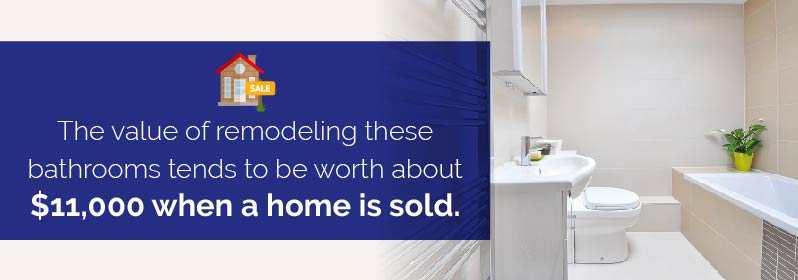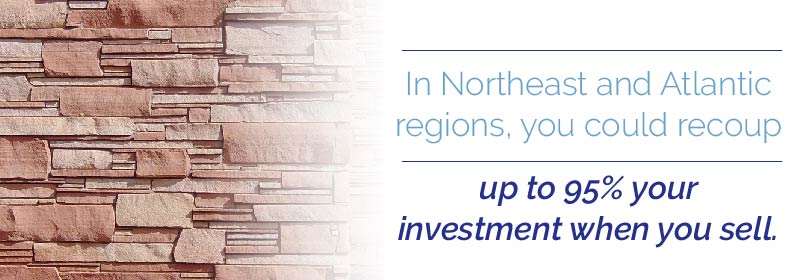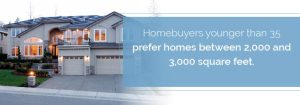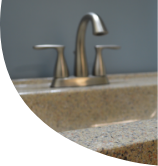Which Home Improvement Pays Off?
Home improvement projects can make your life easier, but they can also pay off in a big way. In some areas, investing in a home improvement project can generate a 100 percent return on investment upon selling the house. If your home is older, has a less desirable layout (for instance, like just one bathroom) or smaller than average square footage for the area, expect to see big returns on your investment.
Unfortunately, not all home improvement projects are equal. Some “upgrades,” like installing a pool, actually decrease the value of your home. These upgrades are less desirable to buyers because they require lots of maintenance.
So what home improvements provide the best return?
Remodeling projects that increase the value of your home the most tend to have a few things in common. These projects are low maintenance, energy efficient and are of high quality. Remodeling kitchens and bathrooms, improving your curb appeal and adding more living space are all projects that tend to pay off when it’s time to sell a home.
We’ve put together a list of ten of the most valuable home improvement projects. These are remodeling projects make a big difference for homeowners, and will pay off when it’s time to sell a house. Whether you’re planning to sell, or just want an update that makes your life easier, these ten projects are all worthwhile candidates.
Kitchen and Bathroom Remodels
Kitchen and bathroom projects are at the top of most home improvement lists. Most homeowners believe that these projects will pay off in comfort, as well as increasing the value of your home. Moreover, they’re right: a second bathroom is at the top of the list, with a rating of 10 out of 10. Kitchen and bathroom remodels aren’t far behind.
Minor Kitchen Remodel
Average cost: $20,122
Return on investment: 83.1%
Minor kitchen remodels strike the perfect balance between updating your home, minimal impact from construction and price savviness. This type of project is a good choice for an older, but structurally functional kitchen. If the basic design of your kitchen works for your family, consider a minor kitchen remodel.
Minor remodels tend to focus on improving performance and aesthetics. Consider replacing older appliances with newer, energy efficient upgrades. Upgrading your stove and refrigerator can both have a big impact on your kitchen.
Most homeowners see the biggest visual impact when replacing cabinetry and flooring. It’s possible to keep your existing cabinet boxes and update them with newer doors. If some of your cabinetry isn’t functional, consider removing it or replacing it with a different design. Many minor kitchen remodels include upgrades to countertops and backsplashes as well.
Bathroom Remodel
Average Cost: $17,908
Return on investment: 65.7%
Bathrooms tend to be an overlooked room. It’s no surprise that many homeowners have bathrooms that haven’t been updated since the house was built. Although they’re functional, these bathrooms might have bad light, old plumbing and outdated designs. The value of remodeling these bathrooms tends to be worth about $11,000 when a home is sold.

Whatever your reason for remodeling, today’s bathroom designs can do a lot to make life easier. Focus on lighting and tile for a big impact that’s incredibly customizable. There’s a wide range of colors and designs available that will let you create your dream bathroom.
If you’re installing a new shower or tub, consider adding built-in niches in the shower or tub surround. They’re convenient for storing soaps and shampoos, and you won’t need to give up space for a shower caddy anymore. Accessibility features are another nice feature that can help older relatives, and pay off in a big way when you sell. Zero threshold showers, which prevent tripping because they don’t have a lip between the shower and the floor, are growing in popularity.
Major Kitchen Remodel
Average cost: $59,999
Return on investment: 64.9%
If your kitchen is too narrow, non-functional or just outdated, a major kitchen remodel may be a useful home improvement project. Like any major renovation, decide the purpose of your project before you jump in. Is it to increase the value of your home? Or do you plan to stay in your house for years, and want a kitchen that works better for you?
The answer to these questions can have a big impact on how you approach remodeling a kitchen. If you’re planning to sell soon, stick with classic appliances, colors and designs. They will appeal to a wider range of buyers. On the other hand, if you’re designing a kitchen for your family, you might get a lot of benefit from more customized appliances.
Because major kitchen remodels are a big project, this is a good time to consult the professionals. These remodels may involve changes to plumbing, walls and electrical wiring. If there’s a second floor above the kitchen, you may also have structural challenges that an architect or engineer will help you address.
One important consideration is customization. Although major kitchen remodels have a lower return on investment than some other projects, they tend to bring homeowners the most happiness. If you’re remodeling for your family, it can be worth splurging on some of those upgrades to make your life easier. Some of the changes that homeowners rate worthwhile include soft glides for drawers, a second sink and paneled cabinet ends. Full backsplashes and adding more light are also generally good investments.
Midrange Bathroom Addition
Average cost: $42,223
Return on investment: 56.2%
Adding a bathroom is a solid investment that can pay off when you sell a house. The average homeowner saw an increase in value of $23,727 from a new bathroom at sale time. However, not all bathroom additions are equal. In general, you’ll see the greatest increase in value of your home if you add a full or three quarter bathroom. Half baths don’t tend to add as much value to a home. Families in particular are looking for bathroom additions that include a tub for the kids.
If your home has just one bathroom, you’re likely to see a much higher than average return on investment. In fact, HGTV estimates that adding a second bathroom to your home can have a return on investment of 80 to 120 percent.

Increasing Curb Appeal
The outside of a house is important. After all, it’s the first thing prospective buyers will see. Small projects to increase your curb appeal can make a big difference when you sell your home. Landscaping and touching up paint will both make a big difference to your home’s appeal. Our list focuses on small renovations — including one you can do yourself — to increase the value of your home.
Adding a Manufactured Stone Veneer
Average cost: $7,519
Return on investment: 92.9%
Adding a manufactured stone veneer is an easy way to increase your curb appeal. This home improvement project replaces the bottom one third of siding on your home with manufactured stone. If you’re considering replacing your siding anyway, adding a stone veneer could be a great investment. And if you’re looking for a way to increase your curb appeal with minimal construction, this project is a great starter.
It’s important to know that the value you get out of this varies based on where you are. In the Northeast and Atlantic regions, you could recoup up to 95 percent of your investment when you sell. In the Pacific Northwest, expect to see much lower returns.

Entry Door Replacement
Average cost: $1,335
Return on investment: 91.1%
Replacing an entry door is another surefire way to improve your home’s curb appeal. It’s one of the first things guests (and buyers) see, so it’s a good strategy to make it look nice. Your door also plays a key role in your home’s safety. Moreover, if you’re handy with tools, this is a project you can do yourself.
For the biggest impact, look for a steel entry door instead of a fiberglass one. These steel doors are stronger, which means that they’re better at keeping out intruders. Many buyers look for steel front doors, even in the safest neighborhoods.
Replacing your front door with an energy efficient model is also a good idea. Heat tends to leak from front doors and windows, so replacing them with a door with insulation and weatherproofing can have real advantages. An energy efficient front door can lower your energy bill by up to ten percent.
Garage Door Replacement
Average cost: $1,652
Return on investment: 91.5%
Replacing your old garage door can also have a big impact on your home’s curb appeal. After all, the garage door is one of the biggest spaces on your home’s exterior. That means it’s one of the first things that potential buyers see. An attractive garage door increases a home’s value by an average of $1,512. That means you’ll recoup about 90 percent of what you spend to have the door installed.
When choosing a garage door, look for an energy efficient model with insulation. An insulated garage door will help to protect your car and any belongings stored during cold winters. And if you’re selling your home, many buyers are interested in energy efficient upgrades.
Design is another important consideration. It’s important for your garage door to blend well with your home’s architecture. Consider whether carriage house doors or a row of decorative windows would add to your home’s curb appeal. Even simple doors can make a statement. Garage doors in a color that contrasts with the rest of a home are increasingly used as statement pieces.
Adding Space
Another effective way to increase the value of your home is to add space. This is particularly true if the house has a relatively small square footage to begin with. Most people want homes that are at least 1,500 square feet. And for many, bigger is better. Homebuyers younger than 35 prefer homes between 2,000 and 3,000 square feet. 5-young-homeowners
Wood Deck Addition
Average cost: $10,471
Return on investment: 75%

Adding a deck to your home is an easy way to add space without undertaking major construction. And because outdoor living has seen a surge in popularity lately, you’ll recoup most of the cost of this project when you sell your home. If the ground is sloped, a deck can also add more usable space to the backyard. The average wood deck costs about $10,000 to install, making it one of the more affordable ways to add living space.
If you’re considering adding an outdoor deck, materials are an important consideration. Many people prefer wood decks to composite decks. Those constructed out of natural lumber will need periodic maintenance to keep them looking their best. Expect to power wash and re-seal it every few years.
Composite decks are much lower maintenance, but don’t have the best reputation. Composite deckboard is relatively new, and many contractors had problems with early varieties of it. Today’s composite boards are very different from the early models. They don’t fade, won’t need to be sealed or stained and can be crafted to look like many varieties of wood.
Two Story Addition
Average cost: $171,056
Return on investment: 69.3%
Adding a second story is a major undertaking. It’s also a home improvement project that tends to pay off. Most homeowners saw their home’s value increase by more than $100,000 when they added a second story. If your family is outgrowing your home, this can also be a great way to stay in the neighborhood.
There are a few different strategies for adding a second story. One of them is to simply lift off your current roof, add a second story, and place the roof back on top. If your roof is relatively new and you’d like to add an entire second story, this can be one of the easiest ways to do it. If ceilings on the first floor feel low, take the time to add a few extra inches.
Another idea is to add a partial second floor. If you don’t need to double your square footage, a partial second floor can be a less invasive option. Consider flat roof surfaces like that over the garage when you’re looking for the best location. Even a partial second floor can easily offer an extra bedroom or two, and a second bathroom.
Master Suite Addition
Average cost: $115,810
Return on investment: 64.1%
A master suite is one of the most popular types of home improvement projects, for good reason. This addition creates a private, retreat like area that scores one of the highest ratings in homeowner satisfaction. On average, homeowners that added a master suite rated it a 9.7 out of 10 on the Joy Scale, a national scale used by realtors to rate home improvement projects.
But what exactly is a master suite, and is it different from a master bathroom? Some architects use the two ideas interchangeably. However, increasingly, a master suite involves a separate vanity area and walk in closet. Other versions of the master suite include fireplaces, sitting areas or a separate office space.
If you’re considering adding a master suite, look for ways to take advantage of existing space. For a master suite on the second floor, consider building above an existing patio instead of extending your home’s foundation. Think about what’s most important to you as well. If you work from home, adding an office to your master suite could be useful. If not, skip this step in favor of an expanded bathroom.
This is one area where a bathroom upgrade pays off. Consider double sinks and a jetted tub. A separate toilet room is also a popular option. Many master suites include a private entrance from the outside, as well.


